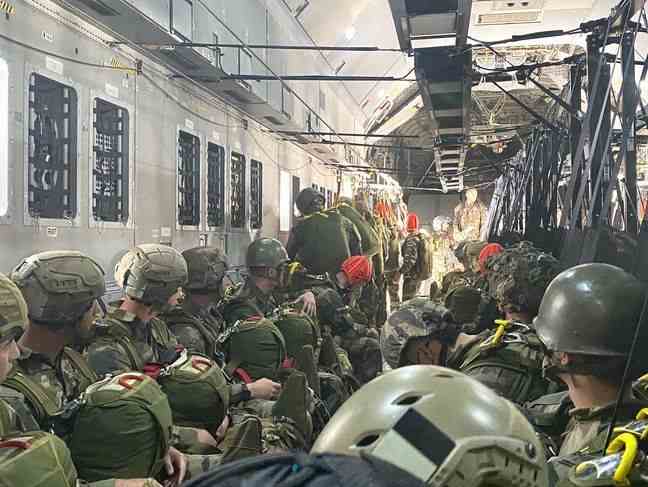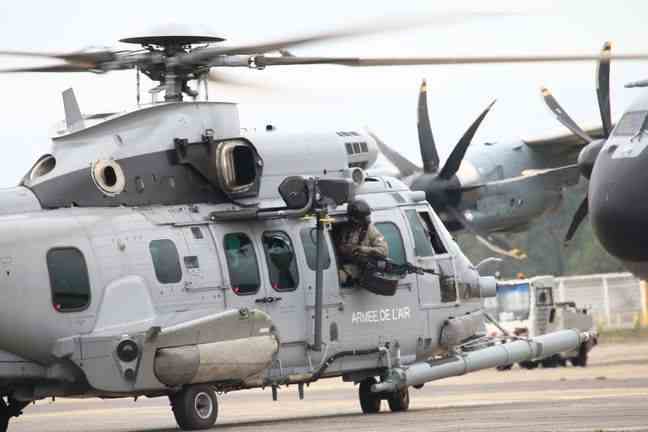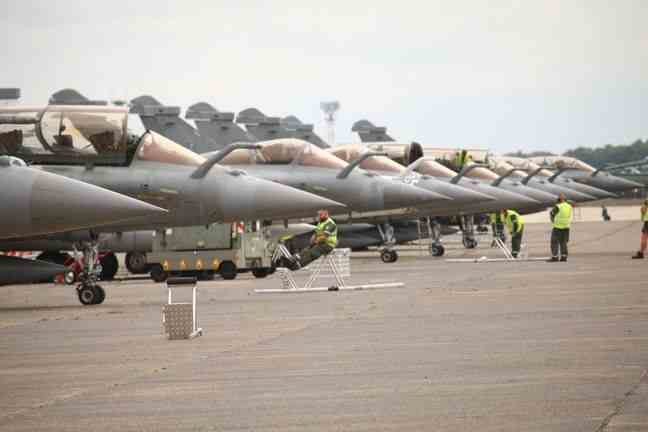After four days of “high intensity” combat, the international coalition suffered the first losses among its troops. Today’s mission will be to send paratroopers into the territory invaded by the enemy, to complement the coalition forces. Five planes will thus take off from the Mont-de-Marsan base (Landes) to penetrate enemy airspace at low altitude, including an A400M accompanied by two Rafales which will fly above, to ward off any threat, and drop commandos. paratroopers in central France.
Exceptionally, 20 minutes was able to board the A400M on Thursday to follow this TAT (Tactical Air Transport) mission, on the occasion of the Volfa military exercise, the annual combat preparation training of the Air Force and the Space, which brings together for three weeks at the BA 118 of Mont-de-Marsan about sixty aircraft and about a thousand soldiers.
Paratroopers take out the paper bags under the seats
“It will not be a walk in the park,” warns Colonel Gilles, director of the Volfa operation, before boarding. “Tactical flight” means that the A400M will have to chain the phases at low altitude to pass under the radar before climbing back up suddenly, multiplying the changes of course according to the enemy threat, or even making U-turns. The objective is to avoid the response and return safely.

When taking a seat in the aircraft, we are advised to strap ourselves to the back of our seat. Completely. Smirking, the paratroopers look at each other. “Have you ever done a tactical flight?” “, they ask, mockingly, taking out the paper bags located under the seats… The pilot activates his four engines, each developing more than 11,000 horsepower, and off we go for a two-hour raid that will prove to be… muscular .
poor visibility
If most of the paratroopers present come from Pau, Julien*, arrives from the marine commando Trépel from Lorient. He is on his 27th jump, and is taking advantage of the Volfa exercise to follow an internship and obtain a higher qualification. “Volfa is an opportunity to jump with our war gear, and in large numbers. This allows you to train closer to reality. At 25, he is already well versed in this type of exercise. However, he recognizes that there is “always a little apprehension before jumping. »
The operation must be carried out at an altitude of 300 meters. Once arrived in the area, the hundred or so parachutists get ready, check one last time that the whole package, which weighs 25 kilos, is well strapped. A moment of great concentration. But visibility is poor. The pilot decides not to take the risk of dropping the troops. Despite a second passage, he operates a U-turn and returns to the base of Mont-de-Marsan. While showing what his A400M has in store during the return flight…
“We are inevitably disappointed not to jump, but these are the hazards when you are a parachutist” continues Julien. “It remains an exercise, and the safety of our soldiers comes first”, insists after the operation General Julien Sabéné, Chief of Staff of the Air Force Command, once the device has finally landed.
“Nations feel they need to prepare”
Like last year, Volfa takes place in three main zones: the Atlantic Ocean, the South-West and the Massif Central, which represents the zone annexed by the enemy which must be sought to be reconquered, and where the ground actions with the commandos. But the exercise, which has existed since 2016, has clearly gone up a notch this year, with seven nations represented (compared to four last year for example) in addition to France.
Greece, Italy, Portugal and the United Arab Emirates who came with their F-16s, the Americans (accounted for by providing a refueling plane) for example responded present, with the Spaniards and the Canadians already there the year past. “For the Emirates, this is a first,” announces Colonel Gilles. We are used to training with them since we have a base on their territory, but this is the first time that they have deployed for an exercise. »
Is this international mobilization the consequence of the war in Ukraine? Yes and no. “With the international context, the nations feel that they need to prepare, agrees the director of Volfa. But the scenario for this edition was established in December 2021, so before the war. We were preparing for high intensity before Ukraine, and we continue to prepare for it. »
General Julien Sabéné confirms that Volfa is in no way a response to the current international situation. “But we can’t pretend that Ukraine doesn’t exist either. Between the planning of the exercise a year ago, and its execution today, we failed two or three things, emphasizing the informational fight, with regard to what is happening in Ukraine, even if it is something that we have seen rising for years. Fake news is now part of our daily life, we see it in all hybrid fights. However, I think that tomorrow’s war will still be different from today’s and we have to stay one step ahead. »
“Crossing Cultures”
This is why Volfa 2022 is intended to be a “multi-place and multi-field” exercise, also including space and cyber components. “We tend in combat aviation to train among ourselves, Volfa’s objective is precisely to decompartmentalize,” explains Lieutenant-Colonel Mathieu, Mirage 2000-5 pilot at the Luxeuil base. We put everyone in a scenario, and we cross all cultures to conduct a global air campaign. »

Transport aircraft, helicopters, commandos, fighters, ground-to-air defense systems… All sectors of the Air Force and Space are thus represented, within a scenario that evolves over time to place the soldiers in real conditions. “The entire Air Force is involved, also with electronic warfare means to meet as in a theater of operations,” continues Colonel Gilles. And if Mont-de-Marsan is at the heart of the operation, this year we have the Istres base which is also participating, and as usual we are operating above the ocean which allows us to have a very large space, some missions being able to mobilize up to forty aircraft, and to perform supersonic flights. »
The Mont-de-Marsan base, “a 24-hour combat tool”
Mont-de-Marsan was not chosen by chance to coordinate the Volfa exercise. Covering an area of 700 hectares, this base has all the necessary infrastructure for such a deployment. On a daily basis, “the base is a 24-hour combat tool, since we have permanent missions, in particular air policing to carry out surveillance of French airspace, recalls its director, Colonel Jean-Michel Herpin. Our Rafales are ready to take off in a few minutes, and we have radars that monitor the entire South-West quarter. »

And since the space component is now integrated within the Air Force, the base commander indicates that “we also have a space protection mission, since we have a satellite tracking radar on the field of Captieux, which allows us to follow the entries in the atmosphere, to see if these can impact the national territory. »
Missions abroad
The colonel also recalls that missions abroad take place from the Mont-de-Marsan base. “The latest example is the EVA (Enhanced Vigilance Activities) mission launched as soon as the Ukraine was invaded on February 24: at 5 a.m. Russian troops crossed the border, before noon two Rafales took off from here, armed , to reassure our NATO allies on the eastern border. Since then, we have continued to carry out these missions, even if the pace has slowed. Mont-de-Marsan can also carry out missions to French overseas territories.
Even if it is of great magnitude, Volfa remains an exercise. No live fire was fired during the three-week operation, which will end on October 14. “But we train all year round on the Captieux shooting range, with an area of 10,000 hectares, or above the ocean,” says Colonel Gilles.
*Name has been changed

